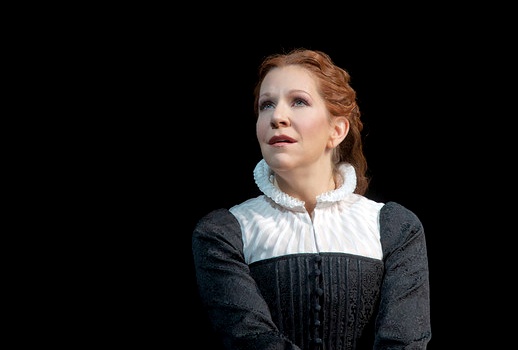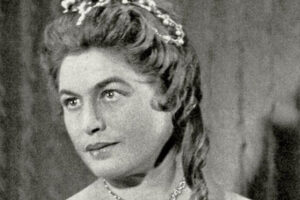

However, if a critic conistently gets too caught up in hyperbole (critical or laudatory), he quickly loses credibility. It’s those damned middling reviews that really exemplify one’s voice as a ”critic.” Those are not that fun to read, and not that fun to write. But you’ll have to bear with me because the Met’s premiere of Donizetti’s Maria Stuarda inspired just such a review.
The opera “crackles with romance,” or so David McVicar tells us. I’m inclined to agree, and so is history. The plot centers around a fictitious meeting between Elizabeth I and Mary Stuart. The libretto is based on a Schiller play that also concocted a love triangle between Mary, Elizabeth and the Earl of Leicester. Rehearsals for the premiere resulted in the singers cast as the two queens breaking into a brawl after the confrontation scene in which Mary spews out the infamous “vil bastarda” (vile bastard) insult.
The world premiere was canceled in Naples after the dress rehearsal, since King apparently wasn’t down with hearing a monarch (of whom his wife was a descendent) called a whore on stage. The piece was revamped but also banned at La Scala, and except for a few scattered performances in the 1860s, was largely ignored for almost a century afterward. It popped up again during the bel canto revival with the help of brilliant sopranos such as Leyla Gencer, Montserrat Caballé and Beverly Sills who couldn’t resist delving into Donizetti’s rich score and the iconic exploits of the martyred Mary Stuart.
Unsurprisingly, the most famous bit of the score is that notorious, censored, verbal smackdown outside of Fotheringhay castle. Stuarda is a diva show through and through. Indeed, yours truly held on tightly to her weave, just in case Elizabeth or Mary got out of hand, reached up and snatched it off my head all the way in the family circle.
First things first: credit where credit is due. Top marks go to David McVicar, John MacFarlane and Jennifer Tipton for fashioning such a beautiful Tudor England . The sets are spacious and unobtrusive. The singers had plenty of space to move about and the emphasis was on human drama and not the spectacle of monarchal Europe. MacFarlane’s elegant constructions are much like those in Charles Edwards’ Trovatore in that there are no awkward lulls in the drama because the sets simply ascend to the rafters to reveal/transform into other sets when their use has expired.

The direction shrewdly focused on the interaction between the characters. Apparently McVicar is not a fan of an unnecessarily cluttered stage. In Act I when the court is awaiting Elizabeth the hustle and bustle was very efficient symmetrical. He must have told choreographer Leah Hausman something to that affect, because even the backflipping court jesters mirrored each other in the opening scene.
And the musical elements are also on a high level. Maurizio Benini did the finest conducting we’ve heard from him at the Met so far, bringing out out some lovely, buoyant playing from the Met orchestra. The orchestra was right with the singers, who seemed committed to the stylem complete with lovely decrescendos on the half cadences followed by portamenti that skillfully linked phrases together and deftly adding to the flow of the music.
Donald Palumbo‘s chorus is proving to be one of the best in the world singing with superb balance and sonority during Mary’s prayer at the end of the opera. Top vocal honors go to the compulsively listenable Matthew Polenzani. It’s nice to see that he is finally getting the recognition he deserves this season with two HD performances. His ringing tenor voice and exquisitely colored phrasing (particularly when he is imploring Elizabeth to have mercy on the Maria) were the high point of the evening. He may well be the best lyric tenor on the Met’s roster.
So much good stuff in this show, right? What the fuck is my beef?
The ladies. They simply missed the mark. Given the vocal and histrionic attributes of these two singers, I found myself wondering what the show would have been like if each had been cast in the other’s role.
Elza van den Heever made an inconsistent Met debut as Elizabeth, more crotchety old lady than fierce rival. Her voice was quite present, but there were were quite a few smeared runs and a handful of curdled top notes. I wanted a little more firmness in the middle voice than she had at her disposal. Still, the phrasing was quite nice and she held her own in her duets with Leicester and Maria. I’d like to see her in another perhaps more gracious role.
Maria Zifchak, Joshua Hopkins and especially Matthew Rose provided sturdy vocalism if little personality to the evening, but that’s beside the point. This is Maria’s show. And unfortunately, the largest disappointment of the evening was the spunky Kansan underdog-cum-diva du jour herself, Miss Joyce DiDonato.
Don’t get me wrong, there was nothing scandalous in the least about her performance. The voice is mostly resonant and true. She has a masterful technique and a command of the style. But she did not convince me that her urgent mezzo was an ideal fit for the part. The pianissimo top tones bordered on straight tone. To my taste this effect can be effective in Baroque repertoire, but in bel canto in quickly becomes grating.
Conversely, her forte singing occasionally found vibrato widening into a bleat. When she had been going full blast in dramatic declamations, and this was followed by a sustained top tone (as in her cabaletta “Nella pace”) the voice thinned out noticeably.
Vocal shortcomings can, however, be overcome by artistic commitment, but that is where DiDonato really disappointed me. It is admirable that she mentioned in her interview with the New York Times that she does not feel the need to compete with ghosts, but the ghosts were out in full force in my mind’s eye last night. So maybe she doesn’t have the diamond bright top tones and stratospheric coloratura of Sutherland or the ethereal pianissimos of Caballé, does she she have the fire of Leyla Gencer? Well, no.

The evening was most infuriating because there was no one to be mad at. It’s so much fun to curse Jonathan Friend for his wretched casting or Peter Gelb for letting him turn the Met into a a pantomime-beauty-pageant-museum for warhorse operas. To the contrary this was exactly what we would hope the Met would be doing; taking a lesser known masterpiece and putting it before a larger audience via movie theatre broadcast in a high quality production with top level artists.
On this particular night all of the elements (beautiful production, clever direction, fabulous conductor and top notch singers) were in place for a great evening yet the performance just didn’t manage to catch fire. I wanted magic complete with shiny high D’s, glittering pianissimos held for an obscenely long time, soul wrenching phrasing, or other such glorious vocal excesses. I wanted fire and blood. I wanted to be hauled out on a stretcher in a state of post-traumatic operatic delirium, but alas, it was not to be. All I got was singers going through the motions.
Stuarda needs that wild sparkle of genius in order to transcend the work from wig-snatching bitch fight to gripping theatre and the ladies just didn’t deliver the goods.
Photos: Ken Howard.
























Comments